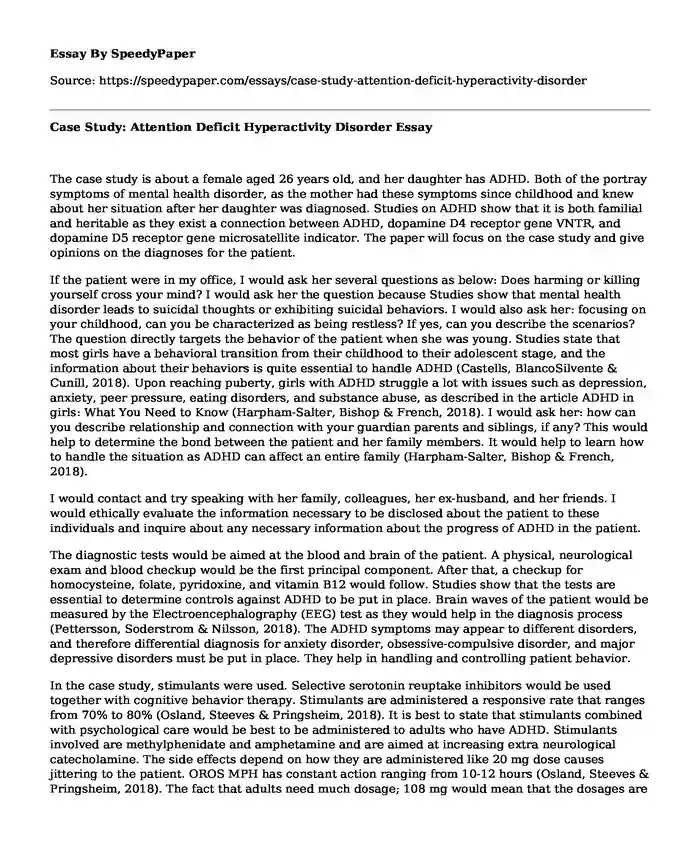
| Type of paper: | Essay |
| Categories: | Culture Nursing Government Justice |
| Pages: | 3 |
| Wordcount: | 769 words |
The case study is about a female aged 26 years old, and her daughter has ADHD. Both of the portray symptoms of mental health disorder, as the mother had these symptoms since childhood and knew about her situation after her daughter was diagnosed. Studies on ADHD show that it is both familial and heritable as they exist a connection between ADHD, dopamine D4 receptor gene VNTR, and dopamine D5 receptor gene microsatellite indicator. The paper will focus on the case study and give opinions on the diagnoses for the patient.
If the patient were in my office, I would ask her several questions as below: Does harming or killing yourself cross your mind? I would ask her the question because Studies show that mental health disorder leads to suicidal thoughts or exhibiting suicidal behaviors. I would also ask her: focusing on your childhood, can you be characterized as being restless? If yes, can you describe the scenarios? The question directly targets the behavior of the patient when she was young. Studies state that most girls have a behavioral transition from their childhood to their adolescent stage, and the information about their behaviors is quite essential to handle ADHD (Castells, BlancoSilvente & Cunill, 2018). Upon reaching puberty, girls with ADHD struggle a lot with issues such as depression, anxiety, peer pressure, eating disorders, and substance abuse, as described in the article ADHD in girls: What You Need to Know (Harpham-Salter, Bishop & French, 2018). I would ask her: how can you describe relationship and connection with your guardian parents and siblings, if any? This would help to determine the bond between the patient and her family members. It would help to learn how to handle the situation as ADHD can affect an entire family (Harpham-Salter, Bishop & French, 2018).
I would contact and try speaking with her family, colleagues, her ex-husband, and her friends. I would ethically evaluate the information necessary to be disclosed about the patient to these individuals and inquire about any necessary information about the progress of ADHD in the patient.
The diagnostic tests would be aimed at the blood and brain of the patient. A physical, neurological exam and blood checkup would be the first principal component. After that, a checkup for homocysteine, folate, pyridoxine, and vitamin B12 would follow. Studies show that the tests are essential to determine controls against ADHD to be put in place. Brain waves of the patient would be measured by the Electroencephalography (EEG) test as they would help in the diagnosis process (Pettersson, Soderstrom & Nilsson, 2018). The ADHD symptoms may appear to different disorders, and therefore differential diagnosis for anxiety disorder, obsessive-compulsive disorder, and major depressive disorders must be put in place. They help in handling and controlling patient behavior.
In the case study, stimulants were used. Selective serotonin reuptake inhibitors would be used together with cognitive behavior therapy. Stimulants are administered a responsive rate that ranges from 70% to 80% (Osland, Steeves & Pringsheim, 2018). It is best to state that stimulants combined with psychological care would be best to be administered to adults who have ADHD. Stimulants involved are methylphenidate and amphetamine and are aimed at increasing extra neurological catecholamine. The side effects depend on how they are administered like 20 mg dose causes jittering to the patient. OROS MPH has constant action ranging from 10-12 hours (Osland, Steeves & Pringsheim, 2018). The fact that adults need much dosage; 108 mg would mean that the dosages are costly. Therefore the administration of stimulants would be the best idea.
I learned that every person responds to medications differently. It is, therefore, a great responsibility to ensure patients with ADHD have the perfect dosage to avoid side effects and determine the dosage that rhymes with the client's current situation. A multigenerational model is required to handle parents with ADHD, who live and care for their children. Therefore, a precise approach that would tackle both parents and children living with ADHD should be considered.
ReferencesCastells, X., BlancoSilvente, L., & Cunill, R. (2018). Amphetamines for attention deficit hyperactivity disorder (ADHD) in adults. Cochrane Database of Systematic Reviews, (8). https://www.cochranelibrary.com/cdsr/doi/10.1002/14651858.CD007813.pub3/abstract
Harpham-Salter, A., Bishop, T., & French, B. (2018). The Adult ADHD Treatment Handbook. Routledge.
Osland, S. T., Steeves, T. D., & Pringsheim, T. (2018). Pharmacological treatment for attention deficit hyperactivity disorder (ADHD) in children with comorbid tic disorders. Cochrane Database of Systematic Reviews, (6). https://www.cochranelibrary.com/cdsr/doi/10.1002/14651858.CD007990.pub3/abstract
Pettersson, R., Soderstrom, S., & Nilsson, K. W. (2018). Diagnosing ADHD in adults: an examination of the discriminative validity of neuropsychological tests and diagnostic assessment instruments. Journal of attention disorders, 22(11), 1019-1031. https://journals.sagepub.com/doi/abs/10.1177/108705471561878
Cite this page
Case Study: Attention Deficit Hyperactivity Disorder. (2023, Jun 01). Retrieved from https://speedypaper.com/essays/case-study-attention-deficit-hyperactivity-disorder
Request Removal
If you are the original author of this essay and no longer wish to have it published on the SpeedyPaper website, please click below to request its removal:
- Essay Example on Social Process Principles and Development
- Free Essay on Gender Equality Management
- Free Paper with Nursing Care Case Studies
- Essay Sample about Federalism and Privacy Rights
- Paper Sample on Switzerland: Marketing Strategy, Human Resource, and Corporate Social Responsibility
- Mandatory Public and Military Service. Paper Example
- Paper Example: Why I Want to Become a Warrant Officer in the US Marine Corps
Popular categories




